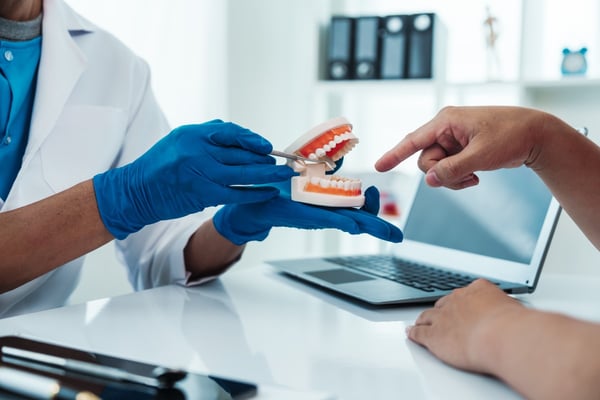Using Patient Education Videos to Support Preventive Care Strategies
As a healthcare provider, you know prevention saves lives. From routine screenings and lifestyle counseling to vaccinations and early detection,...
 If making decisions were simple, we wouldn’t have countless books, seminars, webinars, or conferences with experts weighing in about how to improve the process. One might think decision making, when it comes to choices about our health, would be easier. If we want to stay healthy, we listen to our care team and adhere to their recommendations.
If making decisions were simple, we wouldn’t have countless books, seminars, webinars, or conferences with experts weighing in about how to improve the process. One might think decision making, when it comes to choices about our health, would be easier. If we want to stay healthy, we listen to our care team and adhere to their recommendations.
We know it’s not that simple, especially when it comes to healthcare. Diagnoses and procedures can be scary. And, for some patients, the information needed to make those decisions isn’t easy to understand, available, or accessible. Barriers to patient education can make dental and medical healthcare decisions more complicated, but there are plenty of things healthcare providers can do to help overcome those barriers, improve patient outcomes, and, in turn, improve practice success.
Quick Links:
As healthcare providers, we know one of the most essential elements of our communication with patients, to ensure treatment plan adherence, is patient education about proposed dental treatments and procedures. Unfortunately, there are often barriers to effective patient communication. While there are some common barriers, such as language barriers, some are more complex than that.
When it comes to ensuring patients understand the information presented to them, one common barrier to patient education is the complexity of medical information. Not only does dental and medical jargon or terminology make it difficult for patients to understand health-related concepts, but those same concepts can be intricate and difficult, especially when medical knowledge or literacy are limited. This can lead to confusion and misunderstanding, making it challenging for patients to adhere to treatment plans or make informed decisions about their health.
Another significant barrier to patient education is, as noted above, language but also cultural differences. Patients from diverse backgrounds may speak different languages or have varying cultural norms and beliefs, which can impede effective communication between healthcare providers and patients.
Misinterpretation of information due to language barriers or cultural misunderstandings can lead to declining treatment adherence and patient outcomes. For example, multiple doctors, side huddles, the location of a practice, and more can all create confusion for individuals and impact both provider and patient relationships as well as treatment outcomes.
Another complicating factor for many patients is limited health literacy. Health literacy refers to an individual’s ability to find, gather, understand, and apply information related to their health or current condition.
Low health literacy, typically prevalent in vulnerable populations, can make it difficult for patients to comprehend medical instructions, adhere to treatment plans, or, in general, navigate the healthcare system.
Addressing these barriers requires healthcare providers to employ clear and concise communication strategies, offer patient education in multiple (common) languages or utilize interpretation services when necessary, and tailor educational materials to meet the specific cultural and literacy needs of their patients. And while that may seem like a great deal of effort, not only are the improved patient outcomes worth it, but available tools and resources can simplify the process.
 The Impact of Patient Education Barriers on Patient Health Choices
The Impact of Patient Education Barriers on Patient Health ChoicesUnfortunately, patient education, or a lack of it, ultimately impacts patient health choices and outcomes. And this is critically important in dentistry. Poor patient education can have significant consequences, leading to misunderstandings, non-adherence to treatment plans, and ultimately, poorer health outcomes.
As dental healthcare providers, you’ve likely already seen some of the impacts:
1. Medication Mismanagement- Without education on medication or prescription usage, patients may misuse or overuse prescribed drugs, leading to adverse effects or reduced efficacy. For instance, a patient might misunderstand the dosage instructions for antibiotics, leading to incomplete treatment of an infection and potential antibiotic resistance.
2. Delays in Seeking Treatment- A failure to understand symptoms or conditions may result in delayed medical attention. From the signs of a heart attack to the signs of infection in a tooth or surgical site, poor patient education means they might not seek timely medical help, increasing the risk of, potentially severe, complications.
3. Ineffective Management of Chronic Conditions- Patients with chronic conditions from dental caries (tooth decay), periodontal diseases, tooth loss and oral cancers to diabetes or hypertension may struggle to manage their conditions effectively without proper education. They might not grasp the importance of, for example, a well-balanced diet that’s low in free sugars and high in fruit and vegetables or stopping use of all forms of tobacco to minimize long-term health issues.
4. Failure to Understand Procedures and Consent- Informed consent is crucial in any procedure. Poor patient education may lead to misunderstanding the risks, benefits, and alternatives of treatments or surgeries. Failure to understand all aspects of a procedure may mean patients make health decisions in opposition to their best interests.
5. Mental Health Concerns- When faced with these decisions, patients may feel anxious, stressed, or even depressed, especially if they don’t understand their condition, prognosis, or treatment options. Failure to treat symptoms or ongoing issues may exacerbate these feelings and, long-term, poor patient education can impact overall general well-being and recovery.
When we look at long-term patient outcomes and patient success, it’s clear to see how patient education plays a crucial role in ensuring positive outcomes. Ultimately, practice success metrics and practice health, tied to those outcomes, is then also connected to patient education.
On top of that, patient education is a crucial tool in building patient relationships and trust, which grow in tandem with positive outcomes. It’s all, truly, connected.
The first step to overcoming patient education barriers is ensuring information is clear, accessible, and tailored to individual needs. There are, of course, some specifics to achieving that as well as additional strategies to employ.
Overcoming patient education barriers is crucial for healthcare providers to ensure patients understand their health conditions, treatment options, and preventive measures. These strategies can help.
1. Be a Better Listener- Often, perhaps early on in a provider-patient relationship, a patient will make clear their obstacles. While sometimes those obstacles are more obvious (language barriers), other information they provide can clarify potential barriers and provide you the opportunity to strategize based on their situation.
2. Use Plain Language- It can be difficult, especially when terminology is second nature to you, but avoid technical jargon and use simple, clear language patients can understand.
3. Use Visual Aids and Interactive Tools- Utilizing visual aids such as diagrams, charts, and models can help explain complex concepts, especially if patients can interact with those items. Provide interactive tools like videos, animations, or apps to engage patients in learning, and tailor them to patient conditions, procedures, and treatments. Both of these can encourage better understanding, especially where and when language may fail. Similarly, demonstrations can be valuable when patients might need to learn to use a new device, tool, or treatment method.
4. Enhance Cultural Competency and Sensitivity- Understanding the populations you’re working with is essential. That means learning and knowing about their cultural backgrounds so you can improve cultural awareness. You’ll then be better able to adapt your approach to be sensitive to the patient's background.
5. Encourage Asking Questions- Encourage patients to ask questions to ensure they understand the information provided. This means not only asking “What questions do you have?” where the phrasing matters. It’s different from “Do you have questions?” and assumes that it’s natural to have questions. Further, it means taking the time to answer questions. Impatience or incomplete answers may shut down future questions.
6. Repeat Information- Repeat key points and instructions to reinforce understanding.
7. Encourage and Nurture Family/Caregiver Involvement- Many people rely upon family members, loved ones, and caregivers to make healthcare decisions. Actively involving those folks in the education process can help support the patient and the decision making process. In fact, in some cases, these individuals can help bridge gaps in understanding and facilitate communication.
8. Follow-Up with Patients- Follow-up calls or follow-up sessions are essential to review information and address any additional questions or concerns. Schedule those before a patient leaves the office.
9. Make Educational Materials Available and Accessible- Ensure educational materials and resources are accessible to all patients, including those with disabilities. Further, make sure they’re available when and where they might need them. This also means understanding what kind of accessibility issues a patient may have and supplying materials they can take with them.
10. Personalize Information- Tailor patient education information to a patient's specific health condition, needs, and preferences. If literacy is an issue, health or otherwise, needing patients to extrapolate information based on “similar” conditions or situations may complicate the process.
11. Consider Interpreters or Multi-language Tools- When language barriers are an issue, work with interpreters or tools/resources that have translations available so you can ensure the translated information is accurate.
11. Use of Technology- First and foremost, technology tools, like patient education software, make additional touch points possible without office visits. This can simplify some challenges for patients. However, digital tools can also help you easily share additional resources.
Implementing these strategies, dental providers can help overcome patient education barriers as well as improve health outcomes, patient care, and practice health.
 How Integrated Patient Education Software Can Help
How Integrated Patient Education Software Can HelpEnsuring patients have the information they need to make educated decisions about their care and treatment is a fundamental aspect to any healthcare practice. That said, dental healthcare workflow efficiency, ensuring patients get the care they need while running a successful practice to deliver that care is also essential. Balancing the two? That’s always been a bit more challenging.
That’s where patient education software becomes an incredibly valuable resource. An important and evolving resource area is video education for patients provided by the dental practice -- not the internet. These videos give the dentist or dental team a tool to provide patients with clear and visual understanding and expectations of the procedures and treatments you’re recommending.
Some software even may be branded with your practice name. Now your practice can share with patients both in office and via email or text, enabling them to share it with individuals who will help make decisions. With this approach, it may dissuade the patient from searching Google or WebMD or social media for misinformation or horror stories that can dissuade them from the value and benefits of the treatment or procedure you’re recommending.
Videos can come in a variety of flavors. The most effective are videos that are narrated, especially bilingually (Spanish and English), and easy for patients to understand. You can imagine how quickly these become a valuable tool, in your treatment room and beyond, to overcome patient education barriers and ensure patient adherence to treatment plans.
If improving patient education, treatment adherence, patient satisfaction, and practice revenue are goals, and for most practices they are, then you need to learn about iCoreAcademy. iCoreAcademy is a video library of over 100 ready made videos, providing patients with detailed information for clearer understanding. Learn how this robust video library can complement additional adherence strategies and tools you’re already employing or investigating. Get in touch with the iCore team today and let’s enhance patient education together.

As a healthcare provider, you know prevention saves lives. From routine screenings and lifestyle counseling to vaccinations and early detection,...

There’s no denying that the AI boom is here. The American Medical Association reports that 66% of physicians are currently using artificial...

If only managing your practice’s revenue cycle came with a crystal ball. You could spot claim denials before they happen, predict when patients might...

In the last few years, deaths related to chronic conditions actually went up, despite advancements in medicine that help treat those conditions....

40% of Americans are watching videos online daily. Of the folks who are watching videos, it’s estimated that 95% of them retain the information they...

When we ask dental and healthcare providers about the hardest part of running a practice, many tell us it’s what happens outside the exam...